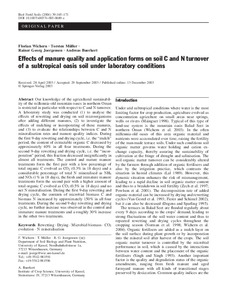| dc.date.accessioned | 2007-05-11T16:03:11Z | |
| dc.date.available | 2007-05-11T16:03:11Z | |
| dc.date.issued | 2003 | |
| dc.identifier.issn | 0178-2762 | |
| dc.identifier.issn | 1432-0789 | |
| dc.identifier.uri | urn:nbn:de:hebis:34-2007051118169 | |
| dc.identifier.uri | http://hdl.handle.net/123456789/2007051118169 | |
| dc.format.extent | 205240 bytes | |
| dc.format.mimetype | application/pdf | |
| dc.language.iso | eng | |
| dc.rights | Urheberrechtlich geschützt | |
| dc.rights.uri | https://rightsstatements.org/page/InC/1.0/ | |
| dc.subject | Rewetting | eng |
| dc.subject | Drying | eng |
| dc.subject | Microbial biomass | eng |
| dc.subject | CO2 evolution | eng |
| dc.subject | N mineralisation | eng |
| dc.subject.ddc | 630 | |
| dc.title | Effects of manure quality and application forms on soil C and N turnover of a subtropical oasis soil under laboratory conditions | eng |
| dc.type | Aufsatz | |
| dcterms.abstract | Our knowledge of the agricultural sustainability of the millennia-old mountain oases in northern Oman is restricted in particular with respect to C and N turnover. A laboratory study was conducted (1) to analyse the effects of rewetting and drying on soil microorganisms after adding different manures, (2) to investigate the effects of mulching or incorporating of these manures, and (3) to evaluate the relationships between C and N mineralisation rates and manure quality indices. During the first 9-day rewetting and drying cycle, i.e. the “mulch” period, the content of extractable organic C decreased by approximately 40% in all four treatments. During the second 9-day rewetting and drying cycle, i.e. the “incorporation” period, this fraction decreased insignificantly in almost all treatments. The control and mature manure treatments form the first pair with a low percentage of total organic C evolved as CO2 (0.3% in 18 days) and a considerable percentage of total N mineralised as NH4 and NO3 (1% in 18 days), the fresh and immature manure treatments form the second pair with a higher amount of total organic C evolved as CO2 (0.5% in 18 days) and no net N mineralisation. During the first 9-day rewetting and drying cycle, the contents of microbial biomass C and biomass N increased by approximately 150% in all four treatments. During the second 9-day rewetting and drying cycle, no further increase was observed in the control and immature manure treatments and a roughly 30% increase in the other two treatments. | eng |
| dcterms.accessRights | open access | |
| dcterms.bibliographicCitation | In: Biology and fertility of soils. Berlin : Springer. 39.2003, H. 3, S. 165-171 | |
| dcterms.creator | Wichern, Florian | |
| dcterms.creator | Müller, Torsten | |
| dcterms.creator | Jörgensen, Rainer Georg | |
| dcterms.creator | Bürkert, Andreas | |
| dc.description.everything | The original publication is available at www.springerlink.com | eng |

